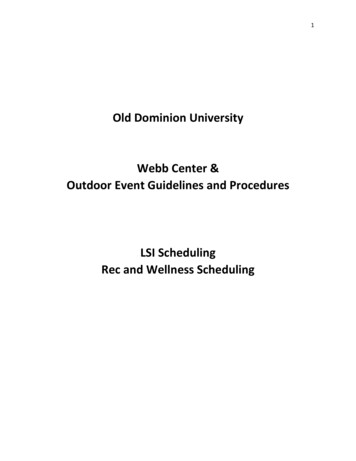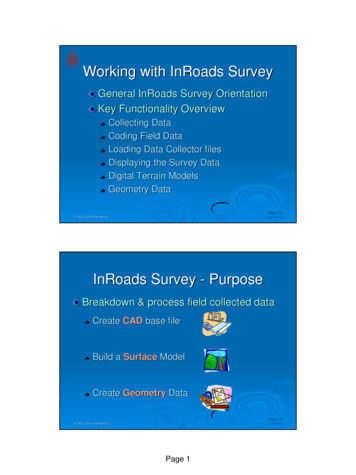
Transcription
GenderSocialInclusion&Manual for FacilitatorsAugust, 2016
Winrock International developed this Gender and Social Manual for Facilitators for theRoom to Learn program in collaboration with the Ministry of General Education andInstruction (MoGEI) of the Republic of South Sudan and the Ministry of Gender andSocial Inclusion. We thank them for their guidance and valuable assistance in thedevelopment of this resource.Room to Learn, which aims to expand inclusive education opportunities and promotesocial cohesion, is made possible by the generous support of the American peoplethrough the United States Agency for International Development (USAID). The contentsare the responsibility of Winrock International and do not necessarily reflect the viewsof USAID or the United States Government.Copyright 2016 Winrock International. Material in this publication may be freelyquoted or reprinted, but Winrock requests a copy of the publication containing thequotation or reprint. Please cite the report as follows:Winrock International. 2016. Gender and Social Inclusion Manual for Facilitators.Created with the support of the United States Agency for International Development(USAID) for use by the Ministry of Education, Science, and Technology of the Republic ofSouth Sudan.
CONTENTSINTRODUCTION . 1Background . 1Objective and Structure of the Manual . 2Facilitator Instructions and Materials. 2MODULE ONE: GENDER AND SOCIAL INCLUSION. 5Session 1: Welcome and Introduction . 7Activity 1.1 (30 minutes): Getting to Know Each Other . 7Activity 1.2 (15 minutes): Training Goal, Objectives, and Ground Rules . 7Session 2: Sex and Gender . 8Activity 2.1 (20 minutes): Understanding Definitions . 8Activity 2.2 (30 minutes): Sex or Gender?. 8Activity 2.3 (30 minutes): Gender Awareness . 10Session 3: Gender Roles & Stereotypes . 10Activity 3.1 (30 minutes): Where Do Gender Roles Come From? . 10Activity 3.2 (30 minutes): Boys Do, Girls Do. 12Activity 3.3 (30 minutes): Gender Roles Case Study . 12Activity 3.4 (45 minutes): Debate—Education . 14Session 4: Social Inclusion . 15Activity 4.1 (10 minutes): What is Social Inclusion? . 15Activity 4.2 (15 minutes): Social Norms . 16Activity 4.3 (15 minutes): Attitudes. 17Activity 4.4 (20 minutes): Displacement . 18Activity 4.5 (20 minutes): Living on the Streets. 19Activity 4.6 (40 minutes): Gender-specific barriers . 20Day 1 Wrap-Up (10 minutes): Gender Advocacy Song . 21MODULE TWO: EQUITY, GENDER-BASED VIOLENCE, AND RIGHTS . 22Activity (10 minutes) Review of Day 1 . 24Session 1: Equity in Education. 24Activity 1.1 (10 minutes) Understanding equity. 24Activity 1.2 (20 minutes): The Fox and the Crane. 24Activity 1.3 (40 minutes) Equity and Resources . 26Activity 1.4 (30 minutes): Gender Equity . 27Room to Learn South Sudan Gender and Social Inclusion Manual for Facilitatorsi
Session 2: Gender-based Violence . 29Activity 2.1 (40 minutes): What is Gender-based Violence? . 29Activity 2.2 (45 minutes): Mapping Gender-based Violence in Schools . 32Activity 2.3 (15 minutes): Tips for Staying Safe . 33Session 3: Psychosocial Well-Being . 34Activity 3.1 (30 minutes): What is Psychosocial Well-Being? . 34Activity 3.2 (20 minutes): Providing support . 36Session 4: Knowing About Rights . 37Activity 4.1 (15 minutes): International Legal Rights . 37Activity 4.2 (30 minutes): Example—Humanitarian Clusters . 38Day 2 Wrap-Up (10 minutes). 39MODULE THREE: ADVOCACY. 40Activity (10 minutes): Review of Day 2 . 42Session 1: Introduction to Advocacy . 42Activity 1.1 (30 minutes): What is Advocacy? . 42Activity 1.2 (30 minutes): What is an Advocacy Campaign? . 42Session 2: Planning an Advocacy Campaign . 45Activity 2.1 (70 minutes): Example—Early Marriage . 45Activity 2.2 (80 minutes): Plan Your Own Campaign . 46Session 3: Ideas for Advocacy . 46Activity 3.1 (15 minutes): Advocacy in Conflict and Post-Conflict Environments . 46Activity 3.2 (30 minutes) Advocacy Ideas . 47Activity 3.3 (30 minutes): Community Dialogue Ideas . 49Session 4: Wrap-up and Training Program Evaluation (30 minutes) . 56Appendix 1: Terms and Definitions . 57Appendix 2: References . 59Appendix 3: For Further Reading. 61Room to Learn South Sudan Gender and Social Inclusion Manual for Facilitatorsii
AcknowledgmentsThis training manual for gender and social inclusion was made possible by theparticipation of many individuals and groups. We would like to thank them for theirtireless efforts in developing and finalising the manual.The Ministry of General Education and Instruction would like to thank the Room toLearn program team—Winrock International and its partners FHI360 and PlanInternational—for leading development of this training manual, with support from theUnited States Agency for International Development (USAID). The workshops based onthis manual will reinforce Ministry efforts to promote gender equity and social inclusionat all levels of education in South Sudan.We wish to thank all those who participated in the review and validation workshop forthe manual, particularly the Ministry of Gender, Child and Social Welfare; State Ministryof Education for Central Equatoria; Girls Education in South Sudan (GESS) program;Handicap International; United Nations Children’s Fund (UNICEF); World FoodProgramme; Windle Trust International; and Management of Systems International(MSI) for their technical support. These partners provided useful information thatshaped the manual.—Honourable Michael Lopuke LotyamUndersecretaryMinistry of Education, Science and TechnologyRepublic of South SudanRoom to Learn South Sudan Gender and Social Inclusion Manual for Facilitatorsiii
Introduction and How To Use This ManualINTRODUCTIONBackgroundAs the world’s youngest nation, South Sudan has made great strides to develop aneducation policy framework and system. The Education Act 2012 has a goal of equitableaccess to education for all citizens and gender equality in education, including forteachers. It states that no child should be excluded from education because of gender,race, culture, language, ability, or social status. This act helped increase enrolment by20% from 2012 to 2015.However, many inequalities remain. Half a million school-age children are not enrolledin school. i Few can go to school, and many who are enrolled drop out before completingprimary or secondary school. The government is committed to inclusive education, butaccessibility standards are not met, and few teachers are trained to address specialneeds. Few schools are able to provide safe, accessible learning for all children. Learnersfrom pastoralist communities and youth with disabilities are generally most excluded.Continuing conflict has had a made it even harder for children to go to school. In 2015,an estimated 866,000 school-aged children were displaced, often to areas withoutschools, or where there are not enough resources and teachers can’t handle morestudents. Around 400,000 children dropped out of school completely. iiThis manual was developed as part of the USAID-funded Room to Learn project to helpthe South Sudan Ministry of General Education and Instruction (education ministry)address gender and social inclusion. The plan was to field-test the manual at aworkshop for ministry workers and revise it based on feedback. With the outbreak ofviolence in Juba in July 2016 and the end of the project in September 2016, this was notpossible. However, Winrock International offers the manual and related handbook tothe ministry, and hopes the ministry will be able to conduct this training at a futuredate.Room to Learn South Sudan Gender and Social Inclusion Manual for Facilitators1
Introduction and How To Use This ManualObjective and Structure of the ManualThe goal of the Gender and Social Inclusion training program is to help people whowork in education in South Sudan understand and make informed decisions aboutgender and social inclusion.The target audience is government workers who are gender focal points—people whohelp raise awareness and understanding of gender issues. The training is not intendedto train trainers. However, participants should be able to share knowledge and skills solocal school community members understand gender and social inclusion in education.This manual, for skilled trainers, has an accompanying handbook for participants. Themanual gives step-by-step instructions for three days of training. The handbook hasdefinitions, illustrations, and handouts, as well as suggestions for community advocacy.It is a reference for participants, not a complete workbook.The manual is organized into three modules, with four sessions in each module:Module 1: Gender and Social InclusionModule 2: Equity, Gender-based Violence, and RightsModule 3: AdvocacyEach module starts with learning objectives and an overview of the sessions andactivities, with approximate timing.At the end of the manual is a glossary of terms and definitions, references, andsuggestions for further reading.Facilitator Instructions and MaterialsGood preparation is essential to the success of your training workshop. These steps willhelp you prepare.Step 1: Reserve a venue.Organize the training in an appropriate learning space. If participants live nearby, theworkshop can be held in short, individual sessions over more time. If participants comefrom different places, a workshop where participants can stay for the three days ispreferred.Let participants know the time and place at least a week before training begins.Step 2: Schedule guest speakers.Room to Learn South Sudan Gender and Social Inclusion Manual for Facilitators2
Introduction and How To Use This ManualAs soon as you have set the date, ask local officials to take part in the opening session.Also invite senior officials at the county and payam levels to make brief remarks on theimportance of gender and social inclusion. If possible, have at least one woman leaderparticipate. Opening remarks by community leaders connect the topic to the communityand set the tone for the workshop.At least two days before the workshop, make sure the officials you’ve invited have theinformation they need for the opening session, including date, time, and purpose of thecourse.Step 3: Arrange special assistance.Find out if any of your participants need special help to participate fully:If your group includes anyone who has trouble seeing, use large print formaterials, or prepare to read all materials aloud.If anyone is hearing impaired, hire a sign language interpreter.Give the workshop in local languages as much as possible for those with limitedEnglish.Step 4: Review participant information and revise the curriculum.Review your participant list 3 to 5 days before the workshop to see who will be there:advocacy group members, teachers, school administrators, and others. Depending ontheir background and needs, you may want to focus more on some topics.You can adjust the curriculum as needed if you ask participants for their reactions eachday. You can use the daily evaluation form or talk with participants. A discussion isoften more useful as people are often more open.Step 5: Create a schedule.Using your proposed curriculum, determine how much time you need for each topic andactivity. You can adjust the schedule based on your participants’ needs. If you have moretime, think about which activities to expand. If you have less time, decide whichactivities to shorten or leave out.Once you have a schedule for each session, try to keep to it. Only go over time if thediscussion is important. Otherwise, it is better to move on. Even with good planning,some activities may take more or less time than expected, so be prepared to alter theschedule.Step 6: Gather materials.Trainers will need these materials: Gender and Social Inclusion Handbook for Participants (one per participant) Writing utensils and markers (Post-it notes, if available) Notebook for each participant Large flipchart paper and a means of sticking it to the wallPrepare and organize materials before each session. Know the handbook so you canrefer participants to the right pages for each activity.Room to Learn South Sudan Gender and Social Inclusion Manual for Facilitators3
Introduction and How To Use This ManualStep 7: Prepare for each sessionBefore each session, make sure you review the activities. Write the objectives for eachsession on the flipchart and post it where participants can see it. If possible, arrangechairs in a circle to make it feel less formal.Step 8: Start and end each day with a review and a previewLet participants know what to expect in your introduction each day. After the first day,review the main points of the previous day and connect them with the current day. Theintroduction is very important when training days are not back-to-back.Start each morning with:1. Housekeeping (food, temperature, etc.)2. Review of the previous day (after day one)3. Preview of the day ahead Objective of the module Schedule for the dayAt the end of each day, do a wrap-up of what was achieved. This can include the shortdaily evaluation, which is often more valuable to the trainer than the final evaluation. Ithelps you understand what participants like or do not like and what they understand ordo not understand.End each day with:1.2.3.4.Participant summary of “what we’ve learned”Trainer review of “where we’ve been”Quick daily evaluation form or discussionIndication of “where we are going” tomorrowRoom to Learn South Sudan Gender and Social Inclusion Manual for Facilitators4
Module 1: Sex, Gender, and Gender AwarenessMODULE ONE: GENDER ANDSOCIAL INCLUSIONObjectivesBy the end of Module 1, participants will: Know the difference between sex and gender and be able to define bothterms Understand how gender roles and gender stereotypes affect their lives andthe lives of children Understand how society encourages women and men, girls and boys tobehave in ways that may not be their choice or the best expression of theirtalents Understand the concept of social inclusion in education Identify different groups of children and youth who face barriers to education Describe the barriers different groups faceRoom to Learn South Sudan Gender and Social Inclusion Manual for Facilitators5
Module 1: Sex, Gender, and Gender AwarenessDay 1 – Module one: Gender and Social InclusionSessionSession 1: Welcome and IntroductionTotal time: 7 hours 40minutesGetting to Know Each Other30 minutesTraining Goal, Objectives, and Ground RulesSession 2: Sex and Gender(45 minutes)15 minutes(1 hour 20 minutes)Understanding Definitions20 minutesGender Awareness30 minutesSex or Gender?Tea break30 minutes(20 minutes)Session 3: Gender Roles and Stereotypes(2 hour 15 minutes)Where Do Gender Roles Come From?30 minutesGender Roles Case Study30 minutesBoys Do, Girls DoDebate – EducationLunchSession 4: Social Inclusion30 minutes45 minutes(45 minutes)(2 hours)What is Social Inclusion?10 minutesAttitudes20 minutesSocial NormsDisplacement20 minutes20 minutesLiving on the Streets(15 mins)Gender-Specific Barriers40 minutesTea breakDay 1 Wrap-up and evaluation20 minutes(10 minutes)Room to Learn South Sudan Gender and Social Inclusion Training ManualPage 6
Module 1: Sex, Gender, and Gender AwarenessSession 1: Welcome and IntroductionActivity 1.1 (30 minutes): Getting to Know Each OtherIntroduce yourself, then pair off participants and ask them to introduce themselvesand share something they hope to get from the training. If participants know eachother, they can say their name and where they are from. This will save time.Ask each participant to introduce his or her partner to the group. This shouldinclude name, community role, and one expectation for the workshop. Asparticipants share their expectations, write them on a flip chart.Invite each to share one thing they like and one thing they do not like about being aman or woman. Give your own example of one thing you like and don’t like aboutbeing your gender. Make sure it reflects gender–something that can be changed. Examples:I have to do all the housework.I am always worried about providing money for my family.My opinions are respected in the community.Facilitator’s Note: In this session, talk about participants’ expectations. Somemay think they will learn something the training will not cover. Others may notknow you expect them to participate actively. Talking about expectations willprevent frustration and build a common understanding of the workshop’s goals.Activity 1.2 (15 minutes): Training Goal, Objectives, andGround RulesRead the goal of the workshop:The goal of this workshop is to develop the skills and knowledge to makeeducation available to all children, girls and boys, of every language, group,and social class.The objectives of the workshop are:1. to expand knowledge, attitudes, and beliefs about gender and socialinclusion2. to plan and implement advocacy campaigns in schools and communities.Lead participants in developing ground rules for the workshop. You may includeexamples such as participation, respect for different opinions, listening to both menand women, not interrupting.Room to Learn South Sudan Gender and Social Inclusion Training ManualPage 7
Module 1: Sex, Gender, and Gender AwarenessAs participants suggest rules for the group, write them on flipchart paper. Once youhave a list, briefly discuss it. Mention that the rules are for everyone, includingtrainers, and everyone is responsible to monitor if they are being followed.Facilitator’s Note: Before each training day, post the rules where all can seethem.Session 2: Sex and GenderActivity 2.1 (20 minutes): Understanding DefinitionsiiiAsk participants: What do you think about when you hear the word “gender”? Whatdoes it mean in your culture? If there is no word for gender, acknowledge that and atthe end of the session, see if participants can describe the concept in their ownlanguages.Explain that it’s important to understand the difference between the word “sex” andthe word “gender.” They mean two very different things.Write on flipchart paper:Sex is based on biology. It is about our physical bodies. Sex is fact.Gender is based on a society’s beliefs. Gender is opinion.Explain that “male” and “female” are the words used for a person’s sex. A person’ssex is male or female. There are many similarities between the sexes but there arealso differences. Which sex you are determines whether you can become pregnant. Afemale can give birth and breastfeed; a male cannot.Gender refers to the roles and behaviours societies or groups assign to orexpect of women and men.Say that we want to talk about some of the roles and expectations that separate thebehaviours and activities of men and women.Activity 2.2 (30 minutes): Sex or Gender?ivTake the participants to a large open space. Mark two places on the ground, one witha sign that says “Sex” and one with a sign that says “Gender.”Explain that you are going to read several statements, each of which is either abiological fact (sex) or a cultural belief (gender). You will read them one by onewhen the activity starts. Do not read the answers.Room to Learn South Sudan Gender and Social Inclusion Training ManualPage 8
Module 1: Sex, Gender, and Gender AwarenessSex or Gender?Women are better cooks than men. (Answer: gender)Men’s voices change at puberty. Women’s don’t. (Answer: sex)Women are shyer than men. (Answer: gender)Women give birth to babies. Men don’t. (Answer: sex)Boys learn faster than girls. (Answer: gender)It’s good for a girl to marry young (Answer: gender)Men make better police than women. (Answer: gender)When a couple can’t have a baby, it’s because the woman is barren. (Answer:gender)Men’s bodies grow larger muscles than women’s bodies. (Answer: sex)Part 1Ask participants whether the statement is about sex or gender and to walk to thesign they agree with, or to stand in the middle if they don’t know. Allow them time todecide.When they have decided, ask volunteers to explain why they made that choice.Ask: “Would anyone like to switch sides?” Allow them to move if an explanation haschanged their view.Reveal the correct answer. Talk as a group about which answer is correct.Part 2Ask participants to return to their seats. Divide them into small groups.Ask each group to share ideas of other social beliefs about men and women. Make ajoke of some examples: women are talkative, men are reserved; women are notintelligent, men are intelligent.Give participants 5 minutes for this activity.Ask the groups the one most interesting thing they discussed.Ask these questions: Were you surprised by how many social beliefs you named? Have you challenged any of these beliefs in your community?Emphasize that social beliefs are created by the community; they’re not based onbiological facts. Gender differences in communities are so deep-rooted, we sometimes don’teven see them. Gender beliefs can be perceived as unchangeable, but they can changebecause of events such as war, famine, and economic conditions. For example, when South Sudanese men fled as refugees to other countrieswithout their families, they had to do some of the things women wouldnormally have done for them, such as washing clothes, cooking food. Whenmen left their families to fight, South Sudanese women had to do activitiesmen would normally have done.Room to Learn South Sudan Gender and Social Inclusion Training ManualPage 9
Module 1: Sex, Gender, and Gender AwarenessActivity 2.3 (30 minutes): Gender AwarenessAsk participants to form groups of four seated near each other. Ask them to talkabout what they think “gender awareness” means.Once they have had time to discuss, ask volunteers to share what they think genderawareness is.Write the definition below on the flipchart and discuss each part with the group.Clarify any misunderstandings:Gender awareness means understanding traditional gender roles, genderdiscrimination, and stereotypes about girls, women, men, and boys.Say that a person with gender awareness: understands the different opportunities and challenges for females and males believes that everyone deserves freedom and fair treatment is willing to make positive changes in their own attitudes and behavioursExplain that education reinforces what a society believes and that school plays animportant part in creating and perpetuating gender roles.In their groups of four, ask them to discuss this question for a few minutes:In school, do female and male teachers have the same opportunities?If not, what are the differences?Ask what differences they found. (This might include: women overwhelmingly teachthe lower grades, men are more likely to be secondary school teachers, especially inmath and science; men are more likely to be principals.)Session 3: Gender Roles & StereotypesActivity 3.1 (30 minutes): Where Do Gender Roles ComeFrom?Explain that a gender role is what family, community, and society expect people todo, based on their sex. Read this definition:Gender roles are a pattern in societies where women have one set of rolesand responsibilities and men have another, regardless of their skills orinterests.Room to Learn South Sudan Gender and Social Inclusion Training ManualPage 10
Module 1: Sex, Gender, and Gender AwarenessGive some examples: women cook and do housework, men are the mainbreadwinners; women are nurses, men are doctors; women wear skirts, men weartrousers; men are assertive, women are not.Explain that in this activity, we will look at one way societies create gender roles andstereotypes.Explain that oral traditions—stories, proverbs, and riddles—reinforce acommunity’s beliefs about what men and women should or shouldn’t do. Traditionalsocieties use stories to explain fixed roles for men and women.Ask a volunteer to read the following tale from an African culture. (Or read the storyyourself.)Traditional Story: When Women Owned CattleLong ago, both men and women in our village owned cattle. Then, one day, abutcher slaughtered a bull in the village square. All the women in the villageran to get some of the meat. In their greed, the women forgot all about theircattle. The women’s cattle wandered off and disappeared. They became thewild animals we have today. The community lost half its cattle and sufferedgreatly.This is why we bar women from inheriting property. Women should do whatthey are best at, like cooking meals for their families. Managing property is aman’s job.Ask the group to reflect on the story. Use the following questions to guide thediscussion:1) According to this story, what are some characteristics all women share?2) What words would a member of this society use to describe women?a. Examples: Greedy, petty, selfish, irresponsible, focused on food3) What is the moral of the story? (The “moral” is the main message or purpose.)Possible responses:a. Women should not be trusted with managing property.b. Any property given to women will go to waste.4) What purpose does this story serve?Possible responses:a. Explains society’s rule that women cannot inherit propertyb. Reinforces traditional gender roles (Cattle herding is for men; cooking isfor women.)Emphasize that this story helps the community explain why it prevents women frominheriting property. Stories like this create powerful barriers to change.Ask participants to share their own examples of local proverbs, riddles, and storiesthat reinforce discrimination against women and girls. For each story, ask:What purpose does this story serve?How does this story strengthen traditional gender roles?Room to Learn South Sudan Gender and Social Inclusion Training ManualPage 11
Module 1: Sex, Gender, and Gender AwarenessActivity 3.2 (30 minutes): Boys Do, Girls DovShow them the flipchart paper “Boys Do, Girls Do” with four sections:Boys DoGirls DoBoys Don’tGirls Don’tDecide on a number of small groups (up to 6 participants) and have participantscount off to form groups. Give each group paper and markers.Part 1Ask the groups to come up with as many messages as they can remember: when youwere a child,
The Ministry of General Education and Instruction would like to thank the Room to Learn program team—Winrock International and its partners FHI360 and Plan International—for leading development of this training manual, with support from the United States Agency for International Development (USAID). The workshops based on










